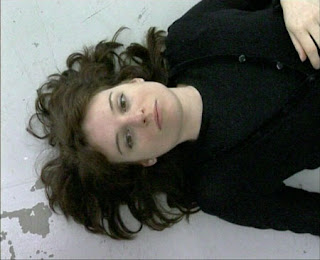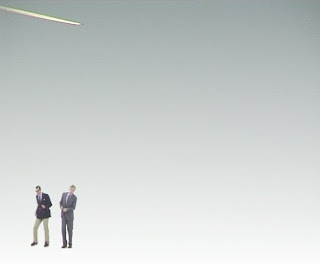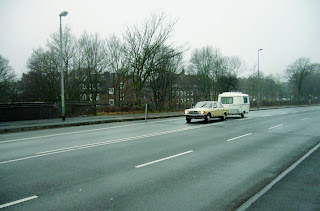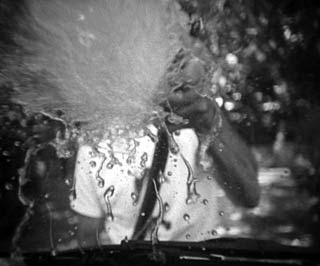
Johanna Billing, Missing Out, 2000, DVD 03:14/LOOP
Having read about the films before seeing them I was interested how different they were to what I'd imagined. One aspect was the amount of psychological tension that comes from your focus on faces and gestures. What status or presence or meaning do you give to a face or a gesture? What do we learn from such an attention to body language?
I cannot say exactly what we learn as this I think is very individual. But I do give a lot of meaning to bodily actions in the film. This is because I try to make films about things I found difficult to verbalise or talk about. Also I am interesting to try to connect to things that we push away inside of us.
And so the people that take part in the films, are many times doing something they would not normally do, or they are put in a situation that is a little bit unusual for them and so they need to concentrate a lot on being there, performing the task at hand. Many times I would talk a lot about what I am interested in and so on, with the people taking part, but some things I can not also explain to people, there are not always given directions. And so the way they respond to the situation is probably that there are a lot of things going on in their minds, they are thinking about what they do while they are doing it, and this often leads to an uncertainty that I believe can say quite a lot of things.
There's a sense of mystery. What holds these groups together? What constitutes their collectivity? What is the point of these groups? Amongst the contributors to Taking the Matter into Common Hands there's an interest in Chantal Mouffe's notion of antagonistic communities. Is that how you would describe the groups here?
Yes, it is a bit of a mystery. And I also somehow want to keep it like that. I like the way you – as a viewer – have to ask yourself these questions. I never work with already consisting groups, or community groups. Many artists today are sometimes asked to do projects with these existing groups in society. I have never been part of that movement. I don’t see my work in that field. The people that take part in my films come from different places and are not normally together as a group. I try to bring different people together for different reasons, depending on what the film is about. In, for example, Missing Out, the people that took part in that film were all from the same generation as me and had been part of a similar activity in kindergarten school when they were six years old: a kind of breathing exercises that was very common in the 70s in Sweden. Apart from that there was not anything else binding them together.
Also, I want to add that, even if it might sound strange here, I never look at the films as being about groups, I always respond to these persons as individuals. The reason I work with groups is perhaps more like a trick to get even closer to the individual. But then of course some films, like these two we are talking about now, are also directly referring to my background, having being brought up in the 70s in the Social Democrat’s Sweden, and having the experience of being in a gap between the memories of more group related activities in society and at the same time being one of the first generations to being able to fully invest in an individual career and personal self fulfilment. So, yes in away there is definitely an antagonistic set up in the back of all this.
But since you brought up the symposium and book Taking the Matter into Common Hands, which I was part of organizing, I have to just quickly say – because it is interesting to make that distinction - that I don’t see my films so connected to these topics in the book as they are not any result of or about collaboration in that way. The films are more films about frustrated situations and isolation, not really social or collaborative actually…The reason I worked with the symposium had more to do with my background of working in a collaborative way with other projects, like an artist run gallery I used to be part of here in Stockholm and also for example a record label, “Make it happen” I am running with my brother since 1997.



Johanna Billing, Project for a revolution, 2000, DVD 03:14/LOOP
I wonder how the films position themselves with regard to experience. In Project for a Revolution I feel I could be watching the activity or the response to some activity, the aftermath or the waiting beforehand. Watching the people in Project for a Revolution also reminded me of being in lectures where everyone is numb, listening to the authority figure speaking. But here there seems to be no lecturer. So then it reminds me of the psychologist Carl Rogers' description of person-centred teaching where there is anger and frustration at his refusal to set the agenda. Do you read the films mood in terms of this anxiety of self determination at the lack of teacher.
It is funny. I have heard this many times. But never actually thought about it as a classroom in that way, that there would /could be a teacher missing. For me it was more about the inability to organize – or break a pattern- about being stuck in something. But I never expected anybody else coming to tell you what to do. For me this was about something not functioning within our selves. It is up to all of us to act. But a general atmosphere – or a dominating way of behaving - in society – or in a room- can prevent you from it.
Do symbols and icons make you uncomfortable? I'm struck by the use of powerful visual symbols in both films - the city of vertical cranes in Missing Out, the blank photocopies in Project for a Revolution - but also how these are made ordinary and mundane within the films. The same is true of your use of moments of dramatic tension - the entrance of the figure into the room that is a non-entrance in Project, for example.
Some of these more stronger, visual or symbolic images are many times the images that the films start with in my head. And like dreamy images many times are, they tend to be quite symbolic. Sometimes the simplicity and the symbolic in them almost embarrass me– but at the same time I find them quite blurry and also many times quite uneasy, and I don’t know exactly what they mean. That for me, many times becomes the reason for making the film. Trying to find out these meanings somehow…so yes, I guess it is true to say that symbols and icons make me quite uncomfortable
Some questions/comments about film style. I didn't experience these films as loops - more like continuations of an event, a continual round of restlessness and personal tics, collapse of time into space.
That is nice to hear, I think of them the same way.

What are you looking for among the groups that leads you to frame a particular arrangement of bodies? Are there certain structures you find appealing - I thought images relating to mirroring often repeated. Do you construct or rehearse images or are they always the result of improvisation?
I am not so much thinking of arranging people… I think a lot of these things are happening just naturally and from improvisation. But then there are – here and there- some more directed parts. For example the birds eye view of people lying on the floor in Missing Out. That was again one of these starting images I had with me in my head.

In 2001 a memory from when I was 6 years old suddenly popped up in my head. I had not thought about it since then, and I have very few visual memories from this period in my life. So I was happy and surprised to be now seeing again this memory from when I was lying on the floor making breathing exercises in the kindergarten school. I remember exactly how it looked like in the room and the more I started to think about it the more I realised that the reason for my remembering this at all, was embarrassingly enough because my teacher had at one point been looking at me and said ”look at Johanna! She is breathing well!” And so the whole idea about memory and that memory is being linked to performance was quite painful but also terrible to realise that even such a basic thing as learning to breath when you are 6 years old can become something that you can become better at than the friend lying next to you.
So this was somehow very interesting for me as it really shows how performance and achievement comes in so early in life, and how much more this has also become part of our stressed life today. So at the same time this memory came up, another image popped up in my head, which was again a breathing exercise –but now with people my own age, and it also confusingly looked like some kind of fashion shooting situation or something, and it was a quite stressful feeling about this well arranged and nice looking image when you looked a little bit closer.
What is the role of the camera? Although it goes through stylistic moves that suggest the creation of dramatic tension or the construction of a coherent space, actually it does not have to fulfill these roles so is free to do something else.
For me it has always been important the way these situations, scenes are framed. It both has to do with the fact again that many times people take part in a situation that is new to them. The participants are also not actors, but many time take part as them selves –but in a constructed situation. So, for me, since the film is not a true documentary it is important to also show that, and to frame it in a way so you can see the construction somehow around it. That is probably what you see as ”stylistic moves” and it creates definitely a fictive aspect in the film. In the end there is always a mix of these fictive framing and at the same time more real elements.


But I am at the same time not specifically interested in the question about what is real and what is fiction. For me the way I move in between these fields have more to do with a wish to create some kind of ambiguity and uncertainty. The way you as a viewer cannot relax when watching it, like you described the feeling of mystery you experience when you have to think a lot about who the people are when watching for example, the same way you perhaps also need to think about what type of film it is, as the film moves back and forth a bit. And when you cannot relax in your mind, I get the feeling there is something else that can come up to the surface – and the film can start to communicate in a sometimes more direct and physical way.
A few questions about the works in the context of the Here We Dance exhibition. A connection you share with other works in the show is of thinking through collectivity or social processes through experiences and/or metaphors of dance and choreography. How did you come to make this connection and how it is useful to you?
All the things we have been talking about here: about wanting to get into a more physical communication- and what meaning I want to give to bodily gestures etc - and also the fact that there is never any verbal communication going on in the films. All those things for me have always made me personally relate some of the films more to choreographies than anything else. The way it is sometimes difficult to find a narrative as well makes it difficult to describe them as short films. So this choreographic aspect of the work has always been very clear and natural to me.
Also very much because I used to be involved in dance myself, not professionally but I used to do free dance and classical ballet, from when I was very young up to when I started to do art, so there is also a direct link for me there. But this aspect of the work has very seldom been part of the contexts around the work, in exhibitions etc. So for me, to be involved in this show now with these two works – that have been shown and ”used” in so many other group exhibitions with other very distinct political and social themes- is a very nice thing. It allows more layers – for example the physical aspect of the works - to be more visible. It is amazing how strong different themes and shows can affect different types of work, making them being seen through different "eyes."
Here We Dance juxtaposes Missing Out with some stills from Yvonne Rainer's Parts of Some Sextet (1965) and War (1970). It establishes a lot of connections between you - use of casual dress, interest in neutrality of posture, subdued use of props and iconography. Is Rainer a key influence or inspiration for your work? What other influences or traditions?
I did actually not know much of Yvonne Rainer or of this work War, where the visual connection is very strong to Missing out. The curators of the Here we dance show were very surprised how I could have missed to see or hear about that. So my acquaintance with the work of Yvonne Rainer is very new. But I am certainly inspired – and can certainly feel connected to it when I see it now!
Other influences for me I think have been film. I am very inspired– even if it is not clearly visible in what I do – by the films of John Cassavetes, the way he worked with improvisation and his interest in the existential. But also the practical aspect of his work, the way he continued to work in an alternative and independent way, not playing by the rules of the film industry. Parallel to film I work a lot with music in different ways, so that is also a big part of my influences. I am also very interested in history, and the way our personal history relates to the more official one.


The key difference is Rainer's use of a conventional performance event set-up with an audience. Where/ what/Who/when is the audience in your films?
Good question. This is a very blurry border for me many times. In some of my earlier projects in the 90s I had a direct wish to go directly to the ”audience” or what I thought could be the audience for specific works or themes, and making them become engaged and part of the project from the beginning. This was very much the case also with for example the film Project for a revolution. Some of the people I wanted to communicate the film to were the same as the ones taking part in the film. Then there is also the other audience that comes in later of course.
It is also interesting to think about how the function of the audience really changed over time. When I first showed Project for a revolution in 2000 in Sweden, I tried to make the film as a catalyst for discussions. The discussion was never in actual silent film, but came after, about how to look at – and talk about the revolutionary engagement without getting stuck in nostalgic images. When it is shown in other countries, it has become something quite different-, something already analysed many times, also years later. But for me it is not less interesting.



Johanna Billing, This is how we walk on the moon, 2007, DVD 27:20 min/LOOP
Finally I wondered if there are key ways you think your work has changed and developed in the films you have made since Missing Out and Project for a Revolution.
I think the question about the audience is probably something that has changed, also because I have been able to show a lot – and experiences from interpretations etc come in and affects how you think. I mean I have been able to understand that it is possible to make something extremely personal and it can still be open and mean something to many different people. That is not as easy when you live in a smaller country with a smaller scene. It is more difficult to focus on the alternative. To meet many different type of audiences in different places has inspired me to dare to be even more personal.
So the fact that I have been working mostly outside of Sweden since I made these two films has changed the work in many ways. From working in a very local focus, dealing with local issues, I have been forced to adapt my work to new situations. This is of course a luxury situation to be able to travel and work like this, but it is still problematic for me to find a balance –between the personal history, and working in new places. You don’t want to end up making superficial comments on other cultures, and you also don’t want to loose your history. That is I guess some of the things I am struggling with right now…
This interview between David Berridge and Johanna Billing took place via e-mail in March- April 2008. Missing Out and Project for a Revolution can be seen as part of Here We Dance at Tate Modern 14 March-26 May 2008.

























